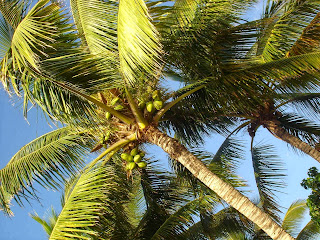Coconuts are inseparable from the lives of those in the tropics, especially in Bali. Each of its parts, starting from the fruit, leaves, and trunk, is useful for various needs in daily activities.
Locals largely utilise parts of the plant for various needs, starting from the fruit, leaves, and trunk. The Balinese have different names for each stage of the coconut fruit’s development with each different function. The smallest fruit that are around 2 or 3 cm in diameter are called bungsil. Village children use bungsil as simple toys. They attach rubber bands to one end and spin it on the ground then raise it ’til it springs like a spinning top as the children cheer on. When the bungsil develops further into the stage that it contains water, it is referred to as bungkak. Religiously, bungkak is considered a fruit that contains holy water. No wonder that many are used in cleansing rituals by sprinkling its water on offerings or places to be ‘purified’.
The Bungkak soon enlarges and contains fleshy layers. This is then called klungah. But the newly formed flesh is still very juvenile and smooth like jelly but sometimes klungah can still be used for purification purposes. Pregnant women are urged to consume the fruit at this stage during their third trimester. The liquid is believed to help ‘cleanse’ the foetus from the fatty foetal layers that envelop it, making for a lighter skin complexion. But the coconut water that is consumed is the air kelapa muda or yeh kuud. The fruit is called kuud when the flesh is thick but still soft. The water of the fruit at this stage is the most flavorful, as it quenches thirst and prevents dehydration as it is rich in electrolytes. It is also believed to be able to neutralize toxins and provide good cholesterol for the body.
Coconut water can also be fermented to produce a beverage called tuak. This is a type of alcoholic beverage that is popular across the archipelago. When the flesh has hardened, the ripe coconuts are referred to as nyuh. The nyuh is best for grated coconut and also processed for cooking oil by mixing it with water. As the coconut milk is squeezed out, the leftover shreds or usam can still be used for polishing parquet to make it shine.
Before the palm oil industry grew into its current giant form, Balinese people were using coconut oil produced from household and cottage industries. The oil making process has a by-product in the form of telengis that can be prepared for consumption. Pesan telengis leftover shreds are wrapped in banana leaves and then roasted are a delicacy and can be found in traditional markets. It is good to note that each part of the coconut can be used. Thus when the flesh is taken for coconut milk or santan, the shell can still be used for utensils such as plates or rice ladles. The fiber can also be weaved and made into doormats.
Langganan:
Posting Komentar (Atom)


0 Response to "Bali - the amazing coconut tree (1)"
Posting Komentar